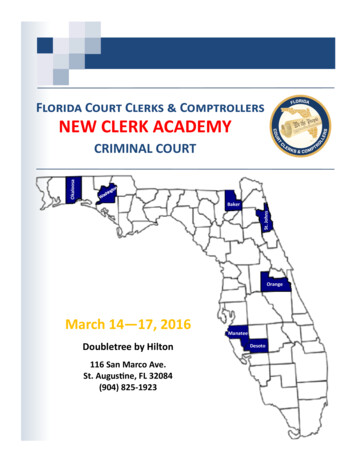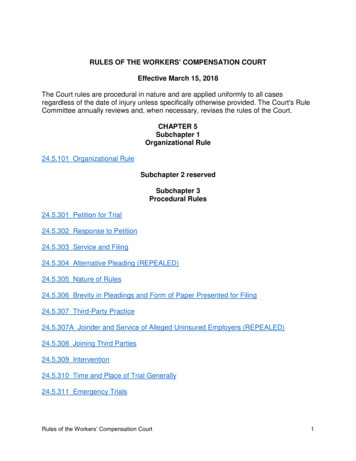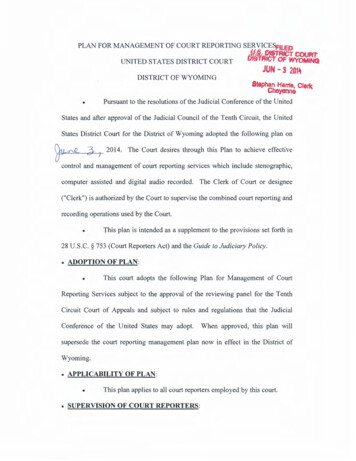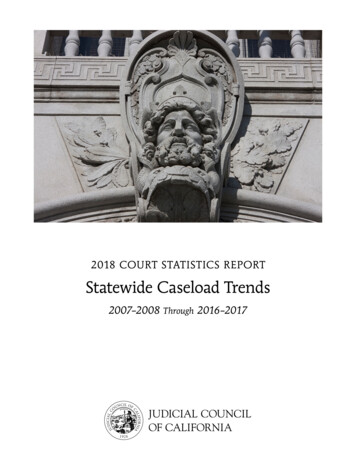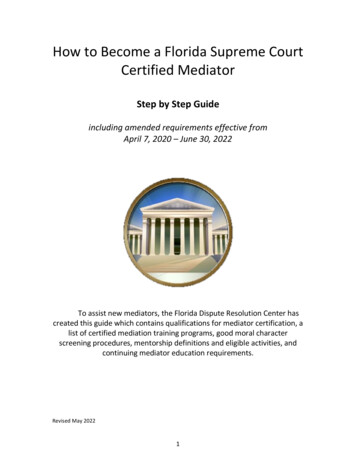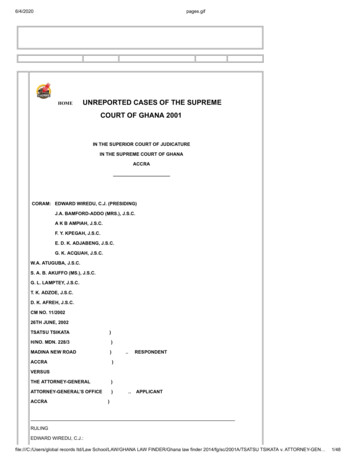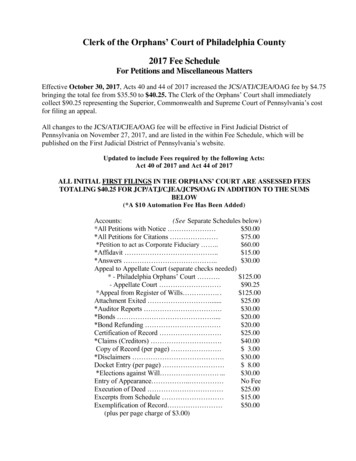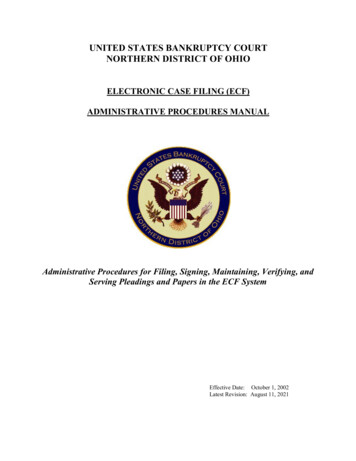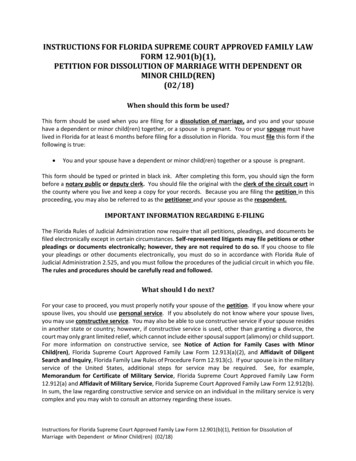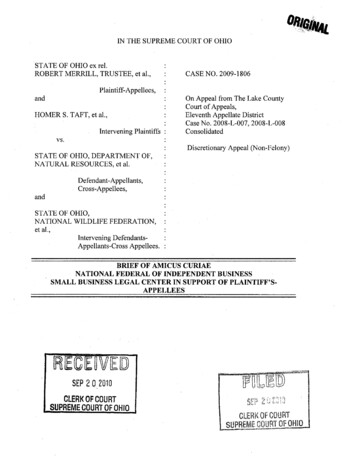
Transcription
IN THE SUPREME COURT OF OHIOSTATE OF OHIO ex rel.ROBERT MERRILL, TRUSTEE, et al.,CASE NO. 2009-1806Plaintiff-Appellees,andHOMER S. TAFT, et al.,Intervening PlaintiffsOn Appeal from The Lake CountyCourt of Appeals,Eleventh Appellate DistrictCase No. 2008-L-007, 2008-L-008Consolidatedvs.Discretionary Appeal (Non-Felony)STATE OF OHIO, DEPARTMENT OF,NATURAL RESOURCES, et al.Defendant-Appellants,Cross-Appellees,andSTATE OF OHIO,NATIONAL WILDLIFE FEDERATION,et al.,Intervening DefendantsAppellants-Cross Appellees.BRIEF OF AMICUS CURIAENATIONAL FEDERAL OF INDEPENDENT BUSINESSSMALL BUSINESS LEGAL CENTER IN SUPPORT OF PLAINTIFF'SAPPELLEESSEP 2 0 2a10CLERK OF COURTSUPREME COURT OF OHIOCLERK OF CCURTSUPREME COURT OF OHIO
Bruce G. Hearey, Esq. (#0009087)LerVal M. Elva, Esq. (#0085441)Ogletree Deakins Nash Smoak &Stewart P.C.Key Tower 127 Public SquareSuite 4130Cleveland, OH 44114(216) 241-6100(216) 357-4733 (facsimile)Bruce.Heare a,ogletreedeakins.comLerVal.Elva(c ogletreedeakins.comCOUNSEL FOR AMICUS CURIAENATIONAL FEDERATION OFINDEPENDENT BUSINESS SMALLBUSINESS LEGAL CENTERRichard CordrayAttorney General of OhioBenjamin C. MizerSolicitor General*Counsel of RecordStephen P. Carney (0063460)Deputy SolicitorCynthia K. Frazzini (0066398)Assistant Attorney General30 East Broad Street, 17th FloorColumbus, Ohio 43215Counsel for Defendant-AppellantCross-Appellee, State of OhioHomer S. Taft20220 Center Ridge Road, Suite 300P.O. Box 16216Rocky River, Ohio 44116Intervening Plaintiff-Appellee-CrossAppellant, Pro SeL. Scot Duncan1530 Willow DriveSandusky, Ohio 44870Intervening Plaintiff-Appellee, Pro Se andCounsel for Intervening Plaintiff-Appellee,Darla J. DuncanJames F. LangFritz E. BerckmuellerCalfee, Halter & Griswold LLP1400 McDonald Investment Center800 Superior AvenueCleveland, Ohio 44114-2688CLASS COUNSEL AND COUNSEL FORPLAINTIFFS-APPELLEES, ROBERTMERRILL, TRUSTEE, et al.Kathleen M. TraffordPorter, Wright, Morris & Arthur, LLP41 S. High StreetColumbus, Ohio 43215Special Counsel for Defendants-AppellantsCross-Appellees,Ohio Department of Natural ResourcesSean Logan, DirectorNeil S. KaganSenior CounselNational Wildlife FederationGreat Lakes Regional Center213 West Liberty Street, Suite 200Ann Arbor, Michigan 48104Peter A. Precario326 South High StreetAnnex, Suite 100Columbus, Ohio 43215Counsel for Intervening DefendantsAppellants-Cross-Appellees,National Wildlife Federation andOhio Environmental Council
TABLE OF CONTENTSTable of Authorities . . iiInterest of the Amicus Curiae .1Statement of Facts .2Order Appealed From and Relief Requested .:.2Argument .:.:.:.:.21. The Court of Appeals Correctly Rejected the OHWM as the Boundary of thePublic Trust .2A. Ohio Law Compels Rejection of the OHWM as the Boundary of thePublic Trust .21. Ohio Supreme Court Precedent Rejects the OHWM as the PublicTrust Boundary .32. Additional Ohio Legal Sources Reject the OHWM Boundary.5B. Practical Considerations Compel Rejection of the OHWM Boundary .6II. Depriving Littoral Rights Owners of the Right to Exclude Will Diminish theValue of the Land .7A. Many Small Businesses Will Be Harmed if Deprived of their Right toExclude .:.:.:.:.::.:.8B. Depriving Business Owners of Their Right to Exclude Amounts to a"Taking" of Private Property .9III. Ohio's Assertion of Trust Ownership Upsets Longstanding Property Rulesand Undermines the Confidence of Business Owners .9IV. This Court's Decision Could Influence Property Rights in Other States .11Conclusion and Relief Requested .13i
TABLE OF AUTHORITIESPage(s)CASESBodi v. The Winous Point Shooting Club(1897), 57 Ohio St. 629 .4, 6;Borax Consol., Ltd. v. Los Angeles(1953), 296 U.S. 10, 56 S.Ct. 23, 80 L.Ed. 9 .:.:.6Brannan v. State(Texas App. 2010), S.W. 3d , 2010 WL 375921 .12City of Mansfield v. Balliett(1902), 65 Ohio St. 451, 63 N.E. 86 .9Glass v. Goeckel(Mich. 2005), 473 Mich. 667 .6Hogg v. Beerman(1884), 41 Ohio St. 81 .4, 10Lamb v. Rickets(1842), 11 Ohio 311, 1842 WL 21 .6McNamara v. Rittman,107 Ohio St.3d 243, 838 N.E.2d 640 .9Oregon ex rel. State Land Bd. v. Corvallis Sand & Gravel Co.(1977), 429 U.S 363, 97 S.Ct. 582, 50 L.Ed.2d 550 .3Rheinfrank v. Gienow (Mar 27, 1973), Franklin App. No. 72AP-298, unreported,1973 Ohio App. LEXIS 1671, *2 . .10Rheinfrank v. Gienow (May 8, 1973), Franklin App. No. 72AP-298, unreported,1973 Ohio App. LEXIS 1543, *3 .10Shively v. Bowlby(1891), 152 U.S. 1, 14 S.Ct. 548, 38 L.Ed. 336 .3Sloan v. Biemiller(1878), 34 Ohio St. 492 .:.3, 6Smith v. Summit Cty.(1988), 131 Ohio App.3d 35, 721 N.E.2d 482 .9ii
State ex rel, Andersons v. Masheter(1964), 1 Ohio St.2d 11, 203 N.E.2d 325 .9State ex rel. Duffy v. Lakefront East Fifty-Fifth Street Corp.(1940), 137 Ohio St. 8, 27 N.E.2d 485 .4, 10State ex rel. Squire v. Cleveland(1948), 150 Ohio St. 303, 82 N.E. 2d 709 .4, 9, 10State v. The Cleveland-Pittsburgh Ry. Co.(1919), 94 Ohio St. 61 113 N.E. 677 .:.4Stop the Beach Renourishment, Inc. v. Florida Dept of Envtl. Prot.(2010), 130 S.Ct. 2592, 177 L.Ed.2d 184 .3U.S. v. Milner(C.A. 9, 2009), 583 F.3d 1174 .:.12OTHER AUTHORITIESOhio Adm.Code, 1501-6-10 (T) and (U) .5Fifth Amendment, United States Constitution .9Fight Over Beach Access Could Go to Supreme Court,http://www.abc-7.com/Global/story.asp?S 12111548 .:.13Moraya Bay Beach Open to the Public-For Now,http://www.naplesnews.com/news/ .121993 Ohio Atty.Gen.Ops. No. 93-025, 1993 Ohio AG LEXIS 27, 11, 15 .51993 Ohio Atty.Gen.Ops. No. 93-025, 1993 Ohio AG LEXIS 15 .71993 Ohio Atty.Gen.Ops. No. 93-025, 1993 Ohio AG LEXIS 11, 16 .:.10Section 19, Article I, Ohio Constitution .9iii
INTEREST OF THE AMICUS CURIAEThe National Federation of Independent Business (NFIB) is the nation's leading smallbusiness association, representing members in Washington, D.C., and all 50 state capitals.Founded in 1943 as a nonprofit, nonpartisan organization, NFIB's mission is to promote andprotect the right of its members to own, operate and grow their businesses. The NationalFederation of Independent Business Small Business Legal Center (NFIB Legal Center) is anonprofit, public interest law firm established to provide legal resources and be the voice forsmall businesses in the nation's courts through representation on issues of public interestaffecting small businesses. To fulfill its role as the voice for small business, the NFIB LegalCenter frequently files amicus briefs in cases that will impact small businesses.NFIB represents about 350,000 member businesses nationwide, and its membershipspans the spectrum of business operations, ranging from sole proprietor enterprises to firms withhundreds of employees. While there is no standard definition of a "small business," the typicalNFIB member employs 10 people and reports gross sales of about 500,000 a year. The NFIBmembership is a reflection of American small business. Many of NFIB's members own retailand service establishments, including small resorts, hotels, restaurants and marinas, with manylocated in Ohio.Amicus represents the interests and views of owners of property along the Great Lakesshorelines who use the property for private residential purposes, and commercial businesses suchas motels, hotels and recreational resorts. NFIB, its members in Ohio, and the NFIB SmallBusiness Legal Center are also interested in the stability of longstanding rules of private propertylaw, protecting existing private property rights and values, and minimizing the potential forfurther litigation between owners of riparian lands along the Great Lakes shorelines and non-1
owners who seek to use or claim an interest in the area of the Great Lakes shorelines landward ofthe water's edge.STATEMENT OF FACTSNFIB adopts and incorporates herein by reference the Statement of the Case and Facts setforth in Plaintiff-Appellee's Merit Brief.ORDER APPEALED FROM AND RELIEF REQUESTEDDefendants-Appellants, the State of Ohio and the Ohio Department of Natural Resources(ODNR) gave notice of their claimed appeal of right and discretionary appeal to appeal theAugust 26, 2009 decision of the Lake County Court of Appeals, Eleventh Appellate District.NFIB urges this Court to affirm the appellate court's decision that Lake Erie property ownershave the right to exclude the public down to the water's edge.ARGUMENTPROPOSITION OF LAWProperty owners enjoy a long-standing right to exclude others from their property andany effort to establish the Ohio High Water Mark (OHWM) as the proper boundary for thepublic trust contravenes that right and established precedent.1. THE COURT OF APPEALS CORRECTLY REJECTED THE OHWM AS THEBOUNDARY OF THE PUBLIC TRUSTA. Ohio Law Compels Rejection of the OHWM as the Boundary of the PublicTrustWhen the United States Supreme Court has engaged the topic of public access to thewaterfront, it has not discussed whether individuals have the right to walk along the shores ofLake Erie, but it has stated that individual states may define property rights on the shore on their2
own. Indeed, in a case frequently cited by Ohio courts, the Supreme Court noted "the laterjudgments of this Court clearly establish that the title and rights of riparian or littoral proprietorsin the soil below high-water mark of navigable waters are governed by the local law of theseveral states." Shively v. Bowlby (1891), 152 U.S. 1, 382, 14 S.Ct. 548, 38 L.Ed. 336. Similarly,the Supreme Court found that attempts to force a federal common law property boundary "mayresult in property law determinations anti-ethical to the desires of the state." Oregon ex rel. StateLand Bd: v. Corvallis Sand & Gravel Co. (1977), 429 U.S 363; 378, 97 S.Ct. 582, 50 L.Ed.2d550. In its most recent decision interpreting littoral property rights, the Supreme Court ruledagainst the littoral property owners but stated "generally speaking, state law defines propertyinterests, including property rights in navigable waters and the lands underneath them." Stop theBeach Renourishment, Inc. v. Florida Dept, of Envtl. Prot. (2010), 130 S.Ct. 2592, 2597, 177L.Ed.2d 184. There, in order to decide the case, the Supreme Court turned to Florida law.Similarly, in this case, this Court must turn to Ohio law. Id. at 2598.Ohio courts have addressed public access to the shores of Lake Erie. And other sourcesalso make clear that private landowners can exclude others from the shore of the lake. Ohiocommon law, ODNR rules, attorney general opinions, and traditional property rights all haverejected the Ohio High Water Mark (OHWM) as the proper boundary for the public trust.Consequently, this Court should reject the OHWM as the proper boundary for the public trust.1. Ohio Supreme Court Precedent Rejects the OHWMas the Public Trust BoundaryThis Court has previously ruled that littoral property owners have the right to exclude thepublic from the shore. Sloan v. Biemiller (1878), 34 Ohio St. 492, 516 (affirming the rights of
property owners in Cedar Point to exclude the public from the shore).'This Court has also rejected the OHWM as the boundary for the public trust when itaffirmed private title to land under the waters of the East Harbor, a harbor connected to LakeErie. Hogg v. Beerman (1884), 41 Ohio St. 81. Although the disputed land fell far below theOHWM, this Court still characterized the property as private land.Six years later, this Court again affirmed the right of private property owners to excludethe public from the shore in Bodi v. The Winous Point Shooting Club, which upheld the right oflandowners to exclude the public from the east end of Sandusky Bay. Bodi v. The Winous PointShooting Club (1897), 57 Ohio St. 629, 630. The Court affirmed an injunction "from enteringupon any of said lands, shores, or marshes, and islands" which were privately owned by theWinous Point Shooting Club for fishing and hunting. Id.In State v. The Cleveland-Pittsburgh Ry. Co. (1919), 94 Ohio St. 61 113 N.E. 677, a casethat the state, misguidedly focuses on for its emphasis on protecting the public trust, this Courtasked the legislature to "in a spirit of justice and equity, provide for the protection and exerciseof the rights of the shore owners." Id. at 84. The case affirmed a decision establishing the right ofprivate property owners to keep the public from coming on their land without their consent. Statev. The Cleveland-Pittsburgh Ry. Co. (Dec. 7, 1914), Cuyahoga App. [no number in original],unreported, 1914 Ohio Misc. LEXIS 163, *35-36, 21 Ohio C.A. 1.Similarly, this Court held that a littoral property owner held title to accreted land despitethe fact that the land lay several feet below the OHWM. State ex rel. Duffy v. Lakefront EastFifty-Fifth Street Corp. (1940), 137 Ohio St. 8, 27 N.E.2d 485. Additionally, in State ex rel.' The state cites to Sloan as well, claiming that Sloan sets the boundary of Lake Erie at the OHWM.Sloan, however, concerned a private contract dispute between two parties and did not discuss theboundary between where the public trust begins and the private landowner's rights end.4
Squire v. Cleveland, this Court held that the natural shoreline of artificial fill, owned by a privateowner, placed in the shallow waters of Lake Erie fell several feet below the OHWM. State ex rel.Squire v. Cleveland (1948), 150 Ohio St. 303, 82 N.E. 2d 709. In sum, throughout Ohio commonlaw, the enforcement of littoral property rights has not depended on the location of the OHWM.Thus, the state's argument that the OHWM is the clear boundary between the public trust andprivate lands in every instance fails.2. Additional Ohio Legal Sources Reject the OHWMBoundaryThe ODNR, Ohio Attorney General Opinions, and traditional property rights reject theOHWM boundary. While none of these sources constitute binding law on this Court, they are allpersuasive authorities.The ODNR has not issued a rule defining "shoreline" as the OHWM. In fact, the ODNRdoes not take a position on the location of the public trust boundary. The rules that do define the"shoreline" in the Ohio Administrative Code, 1501-6-10 (T) and (U), define "shore" as "the landbordering the lake" and "shoreline" as "the line of intersection of Lake Erie with the beach orshore"; showing that the "shoreline" cannot be the OHWM. Ohio Admin. Code 1501-6-10 (T) &(U).Ohio Attorney General opinions also counsel against adopting the OHWM as the publictrust boundary.The Attorney General has specified that "the land that lies above the naturalshoreline of Lake Erie belongs to the littoral property owner" and "the shoreline is the linemarking the edge of a body of water." 1993 Ohio Atty.Gen.Ops. No. 93-025, 1993 Ohio AGLEXIS 27, 11, 15. According to the Attorney General, the "shoreline" is not the same as theOHWM but lies below it. Therefore, according to the Attorney General lands below the OHWMbelong to private owners and the OHWM does not serve as the public trust boundary.5
Traditional property rights also counsel against adopting the OHWM as the public trustboundary. The right to own the shore and right of direct access to the waters are central rights inproperty law. The right to exclude others from one's property is the most central stick in thebundle of property rights. For the State of Ohio to intervene and declare that it suddenly ownsproperty, which private property owners have owned and which has been described in theirdeeds for years, is a direct contravention of property rights of the highest order.This Court has adhered to traditional property rights, recognizing the title of privatepersons to their shores in several cases, including Sloan where this Court affirmed the right ofthose owning property in Cedar Point to exclude others from the shore and Bodi where this Courtaffirmed the right of private property owners to exclude others from the shore of lands in thewest end of Sandusky Bay. Sloan, 34 Ohio St. at 516; Bodi, 57 Ohio St. at 630. This Court hasalso affirmed the importance of the right of direct access to water, noting that grants to the lakemust mean the right to exclude others from the shore because ownership of the shore itself isnecessary to grant property owners direct access to the water. Lamb v. Rickets (1842), 11 Ohio311,314,1842WL21.B. Practical Considerations Compel Rejection of the OHWM BoundaryThe application of an OHWM boundary to a non-tidal body of water such as Lake Erie isinappropriate. An OHWM has little practical application to a body of water such as Lake Erie.Ordinary high or low water originally referred to the daily range of water levels during ordinarytides when the sun and moon are on opposite sides of the earth. See Borax Consol., Ltd. v. LosAngeles (1953), 296 U.S. 10, 27, 56 S.Ct. 23, 80 L.Ed. 9. The great lakes are not affected by thetide but rise and fall seasonally over the course of the year. Glass v. Goeckel (Mich. 2005), 473Mich. 667, 703 N.W.2d 58, 98-99 (Markman, J., dissenting).6
Lake Erie's levels do fluctuate with the seasons. The fluctuations, however, are notreliable enough to serve as an accurate predictor of water levels during the next season. As aresult, for a non-tidal body of water such as Lake Erie, the OHWM fails to serve as an accuratemeasure of the shoreline. As the Ohio Attorney General remarked "naturally, the shoreline of abody of water is in a constant state of change." 1993 Ohio Atty.Gen.Ops. No. 93-025, at 15.Secondly, affinning the Court of Appeals ruling, that the boundary between public andprivate interests is divided at the water's edge, will minimize the chances of fomenting needlesslitigation. The water's edge is an easily identifiable line that anyone, whether a child or a trainedscientist can perceive. Ascertaining the location of the water's edge does not require nearly theamount of resources that ascertaining the location of the OHWM requires. One does not need theexpertise to analyze land forms to know where private rights end and public rights begin; oneonly need to look and see where the water is to become aware of the clear delineation of theserights. Disputes are considerably less likely to arise when the distinction between public andprivate rights is clear to any eye, no matter how untrained.Allowing public access to land that goes beyond the water's edge would lead to conflictsand litigation over the appropriate extent of public use allowed. The public trust doctrine wouldnot help to resolve such conflicts as the doctrine simply refers to an interest the state holds insubmerged lands. Land extending beyond the water's edge, of course, is not submerged and thusnot covered by the public trust doctrine.II. DEPRIVING LITTORAL RIGHTS OWNERS OF THE RIGHT TO EXCLUDEWILL DIMINISH THE VALUE OF THE LANDAllowing public use of land, that was previously not available for public use diminishesthe value and enjoyment of waterfront property. Many small business owners own and operatehotels and other tourist destinations on Lake Erie. These small businesses offer a uniquely7
peaceful retreat to guests. They attract visitors by making shore available to guests that will beunoccupied by the public and thus particularly suitable to a calm, peaceful vacation. Opening theshore to the public could render it unsuitable as a calm retreat for guests. This will reduce theamenities that small business owners can offer to guests, reducing the value of the property.A. Many Small Businesses Will Be Harmed if Deprived of their Right toExcludeDeprivation of the right to exclude will lead to financial loss and diminished propertyvalues. Businesses such as Bay Club Cottages in Put-In-Bay will be directly affected by a ruledeclaring the OHWM as the boundary between public and private rights. Bay Club Cottagesoperates three waterfront cottages on the Southeast Side of Put-in-Bay. The resort offers itsguests a unique experience, the privacy of a waterfront cottage with all of the entertainmentopportunities of Lake Erie. Guests can rent jet skis at the beach during the day and come home totheir quiet, peaceful cottage in the evening.Guests are attracted to Bay Club Cottages because of the combination of a serene cottageexperience and the opportunity to take advantage of thrilling waterfront adventures. The jet skisthat Bay Club Cottages rents sit on the beach between the OHWM and the low water mark. Ifthis Court sets the boundary at the OHWM, Bay Club Cottages will be unable to operate the jetski component of their business as the jet skis would suddenly lie on public land. Jet ski rentalsremain a primary attraction to Bay Club's guests. Without the jet ski component of theirbusiness, Bay Club Cottages no longer can offer its guests the full enjoyment of Lake Erie andwill necessarily lose business.8
B. Depriving Business Owners of Their Right to Exclude Amounts to a"Taking" of Private PropertyNegation of the littoral property owner's right to exclude the public from land beyond thewater's edge destroys a fundamental element of property and will result in an unconstitutionaltaking of property. Setting the public trust boundary at the OHWM would deny littoral ownersthe right to exclude others, a right inherent in the concept of private property. This Court hasheld that a littoral owner is entitled to compensation for "the loss or interference with his right ofaccess to navigable water." State ex rel. Squire, 150 Ohio St. at 338. As such, when the statedestroys riparian rights "the owners of such rights are entitled to compensation for the loss theyhave suffered," McNamara v. Rittman, 107 Ohio St.3d 243, 248, 2005-Ohio-6433, 838 N.E.2d640; see also City of Mansfield v. Balliett ( 1902), 65 Ohio St. 451, 63 N.E. 86; Smith v. SummitCty. (1988), 131 Ohio App.3d 35, 721 N.E.2d 482; State ex rel. Andersons v. Masheter ( 1964), 1Ohio St.2d 11, 203 N.E.2d 325. For the state to claim land for the public trust when that land hasbeen described in private property owners' deeds for years is a destruction of riparian rights,entitling the private property owners to just compensation pursuant to the Ohio Constitution andU.S. Constitution. Section 19, Article I, Ohio Constitution; Fifth Amendment, United StatesConstitution.III. OHIO'S ASSERTION OF TRUST OWNERSHIP UPSETS LONGSTANDINGPROPERTY RULES AND UNDERMINES THE CONFIDENCE OF BUSINESSOWNERSBusiness owners rely on established property rules in building their businesses. Settingthe boundary at the OHWM would upset longstanding property rules. As early as 1884, propertyowners have relied on the fact that the OHWM is not a strict boundary between private andpublic lands. This Court rejected the OHWM as the boundary several times, affirming private9
title to lands well below the OHWM. See Hogg, supra; State ex rel. Duffy, supra; State ex rel.Squire, supra.In the 1970s, the State through the Department of Public Works declared that "theboundary line between Claimants' property and the waters and bed of Lake Erie adjacent toClaimants' property is coincident with the shoreline of Lake Erie." Rheinfrank v. Gienow (Mar.27, 1973), Franklin App. No. 72AP-298, unreported, 1973 Ohio App. LEXIS 1671, * 2. Whileon appeal, the Director and the Ohio Attorney General submitted a court stipulation and swornaffidavit stating that the boundary of Lake Erie could be determined using "mean low water" asthe boundary. Rheinfrank v. Gienow (May 8, 1973), Franklin App. No. 72AP-298, unreported,1973 Ohio App. LEXIS 1543, *3.In the late 1970s, ODNR described the boundary as the line where "land and watermeet." This boundary, ODNR stated, was "normally used to determine where the state's rightsover the bed of Lake Erie begin." ODNR later asked the Ohio Attorney General for clarificationon the proper boundary and he stated that a "littoral owner along Lake Erie holds title to theextent of the natural shoreline," which he defined as "the edge of a body of water." 1993 OhioAtty.Gen.Ops. No. 93-025, at 11, 16.Then, in an about face, in the mid 1990s, ODNR claimed land for the state of Ohio thatwas listed in private property owners' deeds as belonging to them. ODNR began requiringlittoral property owners to enter into submerged land leases with the state of Ohio in order to useland located below the OHWM. ODNR stepped in and took this action despite many decisionsby this Court affirming private title to land under the OHWM and despite a history of decliningto claim the OHWM as the boundary.10
Maintaining the boundary between public and private interests on the water's edge allowsthe public to engage in activities that are consistent with the public trust while allowing littoralproperty owners to fully exercise rights inherent in the ownership of property along Lake Erie.This approach strikes the best balance between two critical objectives: maintaining the publictrust so that the public may enjoy the water while affirming littoral property owners' rights.Businesses rely on longstanding property rules to operate their businesses. Knowing thatcourts have affirmed private title below the OHWM, businesses have operated with confidencethat they own land up to the water's edge, as stated in their deeds. Businesses such as NFIBmember Bay Club Cottages relied on these rules when making commercial investments. Crucialto Bay Club Cottages business is the placement of jet skis on the beach. If the boundary is theOHWM, because the OHWM is difficult to discern, businesses owners like Bay Club Cottageswill be unaware which land is theirs and which belongs to the public. A boundary located at thewater's edge allows Bay Club Cottages to place their jet skis on the beach without concern thatthe jet skis sit on land that belongs to the public. Numerous waterfront businesses, like Bay ClubCottages, depend on these long-established property rules.IV. THIS COURT'S DECISION COULD INFLUENCE PROPERTY RIGHTS INOTHER STATESAll over the country, waterfront property owners' rights are being called into question.Decisions on cases like this one could influence other courts and help mold the legallandscapeof property on the coasts and shorelines. If this Court refuses to depart from the descriptions inthe property owner's deeds, the decision will bolster waterfront property owners' confidence thattheir property rights will be upheld, encouraging them to maintain and expand their businesses.This decision could serve as permissive authority in other Courts that address similar questions.11
In Texas, several beachfront property owners purchased vacation homes that were once200 feet away from the Gulf of Mexico. Brannan v. State (Texas App. 2010), S.W. 3d2010 WL 375921 at * 2. Because of Tropical Storm Frances in 1998, Texas beaches began toerode, moving the vegetation
COUNSEL FOR AMICUS CURIAE NATIONAL FEDERATION OF INDEPENDENT BUSINESS SMALL BUSINESS LEGAL CENTER Richard Cordray Attorney General of Ohio Benjamin C. Mizer Solicitor General *Counsel of Record Stephen P. Carney (0063460) Deputy Solicitor Cynthia K. Frazzini (0066398) Assistant Attorney General 30 East Broad Street, 17th Floor Columbus, Ohio 43215
